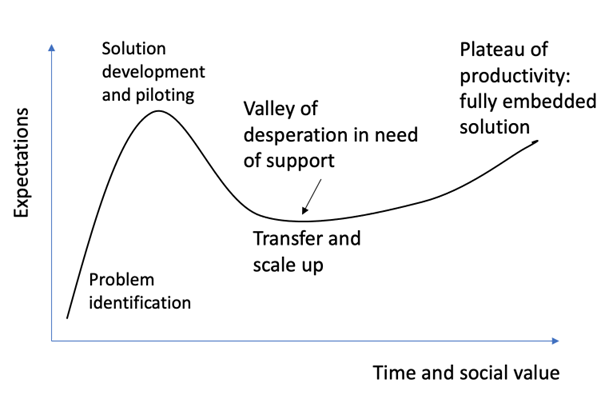Social innovation has been close to the heart of policy programmes around the world, as they aim to tackle poverty, overcome social exclusion, and empower minorities. One might hear the phrase “social innovation” both in policymaker circles and among professionals working for NGOs – but why is social innovation so important?
The main reason: social innovation helps to create new social policy tools that are more effective and/or efficient, if compared to their already existing equivalents. This aids policy programmes to save more taxpayers’ money and/or produce larger outputs and impacts. One of the first and most important steps in the development of social innovation is to conduct social experimentation of a proposed solution. Social experimentation refers to policy interventions that offer an innovative response to social needs, implemented on a small scale and in conditions that enable their impact to be measured, prior to being implemented in other contexts or on a larger scale.
The EU has been supporting social experimentation efforts both financially and administratively through a variety of tools, most notably the EU Programme for Employment and Social Innovation, also known as EaSI. Throughout its 2014-2020 calls, EaSI has supported more than 40 different social experimentation projects, with some of them still ongoing as of 2022. In 2020, Visionary Analytics was commissioned to conduct a comprehensive assessment of these projects. Having concluded our assessment study, we are excited to share with you some of the main lessons and findings.
Key findings
While most social experimentation projects succeed in the implementation of their initial objectives set out in the funding agreements with the EU, not as many proceed with attempts to upscale/transfer their innovative solutions or succeed at embedding them at the national policy level as can be seen from the image below.
Figure 1. EaSI 2014-2020 social experimentation projects statistics.
Source: Own elaboration.
Why does this happen? We identified two key reasons. #1: some project teams demonstrate low capacities in evaluation. In other words, they cannot demonstrate robust measurable evidence of their solution being superior to others. This becomes a key hindrance on the way to engaging private investors and national policymakers when it comes to generating additional funds for upscaling or transferring the developed solution. #2: social experimenters often need additional guidance and support after they successfully piloted their solution as they fall into the “valley of desperation”.
Figure 2. Illustrated process of the development of an innovation solution.
Source: Own elaboration.
However, most project teams, who participated in EaSI, have also benefitted from both EU-level exposure, multi-stakeholder cooperation, and resulting knowledge spillovers. This combination has been particularly helpful for some of the most successful projects to aggregate additional investment and try to push for further upscaling and transfer. Our late 2021 estimates show that every €1 of EaSI investment has generated approx. €2 of additional investment from other stakeholders.
To ensure that the EU can leverage even more effects from its programmes supporting social innovation and social experimentation, we have also made targeted recommendations. Some of them are already being implemented in the new ESF+ programme framework. For example, a newly established system of National Contact Points in the EU Member States will be providing free consulting services as well as ensure evaluative capacity building. At the same time, stricter and more measurable evaluation requirements have been established to help the future project teams better showcase effectiveness and efficiency of their solutions.
If you are curious to find out more about the details of the study, check out the full report here.




